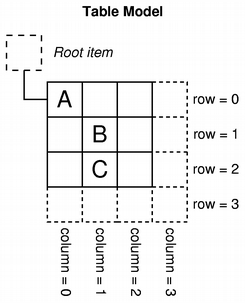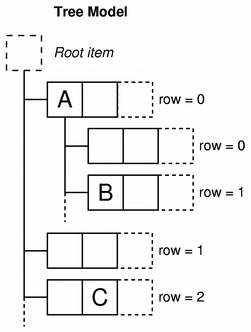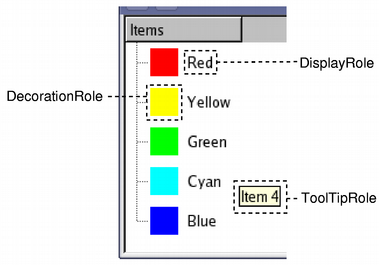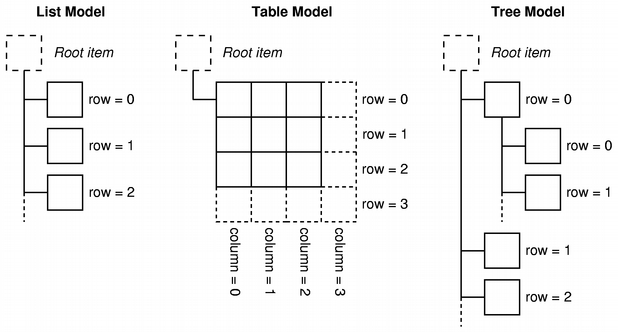Model Classes
|
 | Rows and columns The diagram shows a representation of a basic table model in which each item is located by a pair of row and column numbers. By passing the relevant row and column numbers to the model we obtain a model index that refers to an item of data. QModelIndex indexA = model->index(0, 0, QModelIndex()); QModelIndex indexB = model->index(1, 1, QModelIndex()); QModelIndex indexC = model->index(2, 1, QModelIndex()); Top level items in a model are always referenced by specifying QModelIndex() as their parent item. This is discussed in the next section. |
Parents of Items
The table-like interface to item data provided by models is ideal when using data in a table or list view; the row and column number system maps exactly to the way the views display items. However, structures such as tree views require the model to expose a more flexible interface to the items within. As a result, each item can also be the parent of another table of items, in much the same way that a top-level item in a tree view can contain another list of items.
When requesting an index for a model item, we must provide some information about the item's parent. Outside the model, the only way to refer to an item is through a model index, so a parent model index must also be given:
QModelIndex index = model->index(row, column, parent);
 | Parents, rows, and columns The diagram shows a representation of a tree model in which each item is referred to by a parent, a row number, and a column number. Items "A" and "C" are represented as top-level siblings in the model: QModelIndex indexA = model->index(0, 0, QModelIndex()); QModelIndex indexC = model->index(2, 1, QModelIndex()); Item "A" has a number of children. A model index for item "B" is obtained with the following code: QModelIndex indexB = model->index(1, 0, indexA); |
Item Roles
Items in a model can perform various roles for other components, allowing different kinds of data to be supplied for different situations. For example, Qt::DisplayRole is used to access a string that can be displayed as text in a view. Typically, items contain data for a number of different roles, and the standard roles are defined by Qt::ItemDataRole.
We can ask the model for the item's data by passing it the model index corresponding to the item, and by specifying a role to obtain the type of data we want:
QVariant value = model->data(index, role);
 | Item roles The role indicates to the model which type of data is being referred to. Views can display the roles in different ways, so it is important to supply appropriate information for each role. The Creating New Models section covers some specific uses of roles in more detail. |
Most common uses for item data are covered by the standard roles defined in Qt::ItemDataRole. By supplying appropriate item data for each role, models can provide hints to views and delegates about how items should be presented to the user. Different kinds of views have the freedom to interpret or ignore this information as required. It is also possible to define additional roles for application-specific purposes.
Summary of Concepts
- Model indexes give views and delegates information about the location of items provided by models in a way that is independent of any underlying data structures.
- Items are referred to by their row and column numbers, and by the model index of their parent items.
- Model indexes are constructed by models at the request of other components, such as views and delegates.
- If a valid model index is specified for the parent item when an index is requested using index(), the index returned will refer to an item beneath that parent item in the model. The index obtained refers to a child of that item.
- If an invalid model index is specified for the parent item when an index is requested using index(), the index returned will refer to a top-level item in the model.
- The role distinguishes between the different kinds of data associated with an item.
Using Model Indexes
To demonstrate how data can be retrieved from a model, using model indexes, we set up a QDirModel without a view and display the names of files and directories in a widget. Although this does not show a normal way of using a model, it demonstrates the conventions used by models when dealing with model indexes.
We construct a directory model in the following way:
QDirModel *model = new QDirModel;
QModelIndex parentIndex = model->index(QDir::currentPath());
int numRows = model->rowCount(parentIndex);
In this case, we set up a default QDirModel, obtain a parent index using a specific implementation of index() provided by that model, and we count the number of rows in the model using the rowCount() function.
For simplicity, we are only interested in the items in the first column of the model. We examine each row in turn, obtaining a model index for the first item in each row, and read the data stored for that item in the model.
for (int row = 0; row < numRows; ++row) {
QModelIndex index = model->index(row, 0, parentIndex);
To obtain a model index, we specify the row number, column number (zero for the first column), and the appropriate model index for the parent of all the items that we want. The text stored in each item is retrieved using the model's data() function. We specify the model index and the DisplayRole to obtain data for the item in the form of a string.
QString text = model->data(index, Qt::DisplayRole).toString();
// Display the text in a widget.
}
The above example demonstrates the basic principles used to retrieve data from a model:
- The dimensions of a model can be found using rowCount() and columnCount(). These functions generally require a parent model index to be specified.
- Model indexes are used to access items in the model. The row, column, and parent model index are needed to specify the item.
- To access top-level items in a model, specify a null model index as the parent index with QModelIndex().
- Items contain data for different roles. To obtain the data for a particular role, both the model index and the role must be supplied to the model.
Further Reading
New models can be created by implementing the standard interface provided by QAbstractItemModel. In the Creating New Models chapter, we will demonstrate this by creating a convenient ready-to-use model for holding lists of strings.
[Previous: Using Models and Views] [Contents] [Next: Creating New Models]
| Cette page est une traduction d'une page de la documentation de Qt, écrite par Nokia Corporation and/or its subsidiary(-ies). Les éventuels problèmes résultant d'une mauvaise traduction ne sont pas imputables à Nokia. | Qt qtextended4.4 | |
| Copyright © 2012 Developpez LLC. Tous droits réservés Developpez LLC. Aucune reproduction, même partielle, ne peut être faite de ce site et de l'ensemble de son contenu : textes, documents et images sans l'autorisation expresse de Developpez LLC. Sinon, vous encourez selon la loi jusqu'à 3 ans de prison et jusqu'à 300 000 E de dommages et intérêts. Cette page est déposée à la SACD. | ||
| Vous avez déniché une erreur ? Un bug ? Une redirection cassée ? Ou tout autre problème, quel qu'il soit ? Ou bien vous désirez participer à ce projet de traduction ? N'hésitez pas à nous contacter ou par MP ! | ||
Copyright © 2000-2012 - www.developpez.com




















